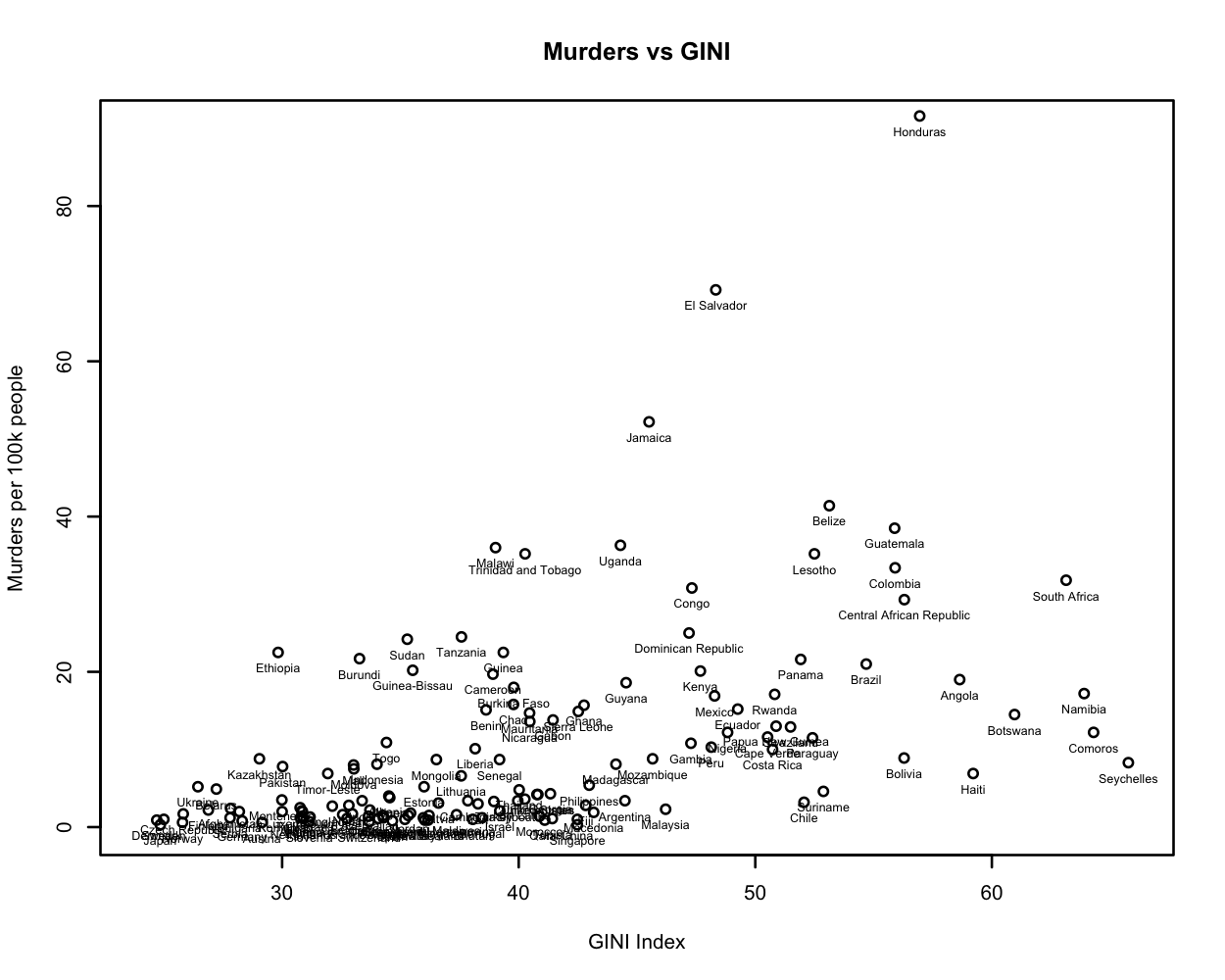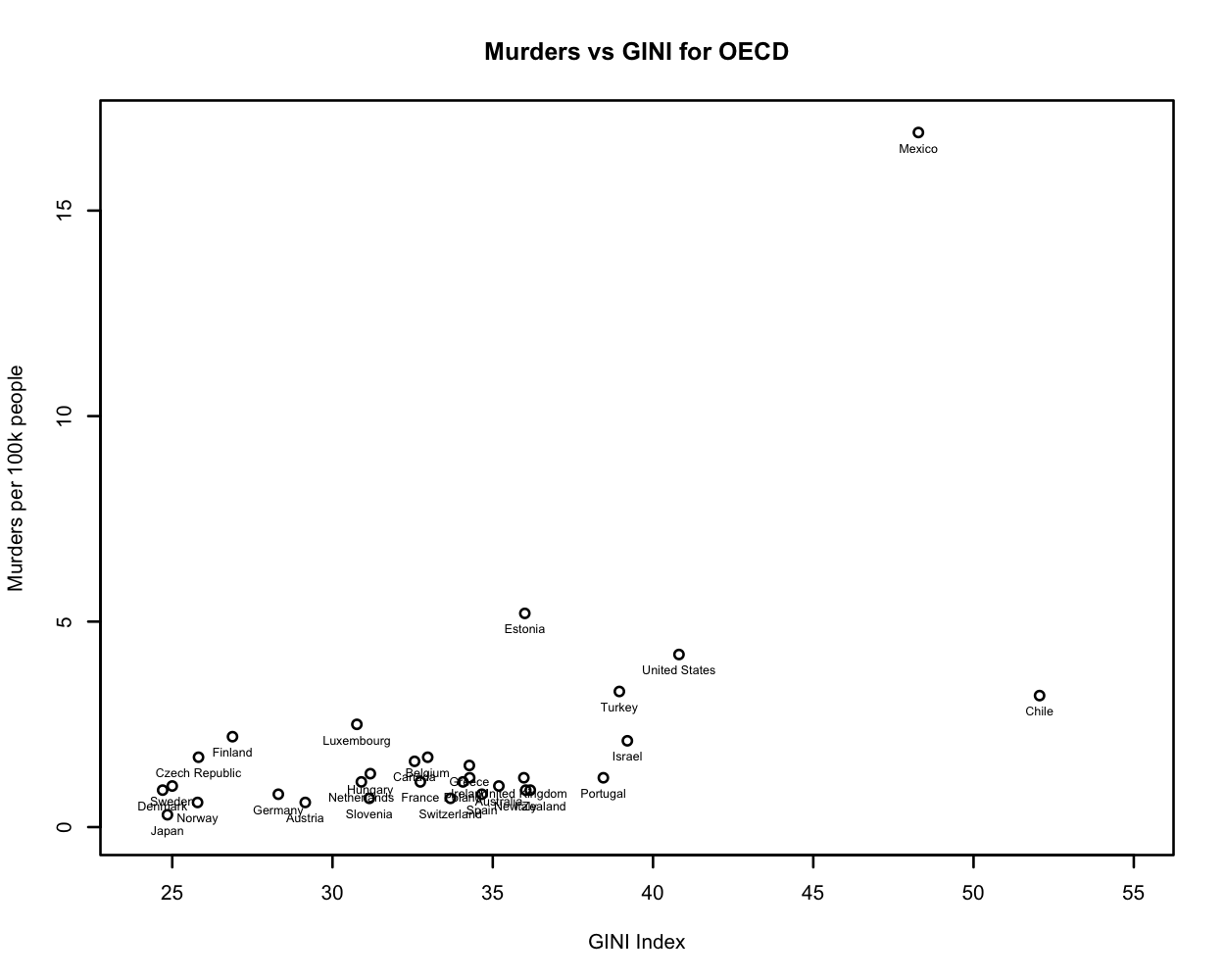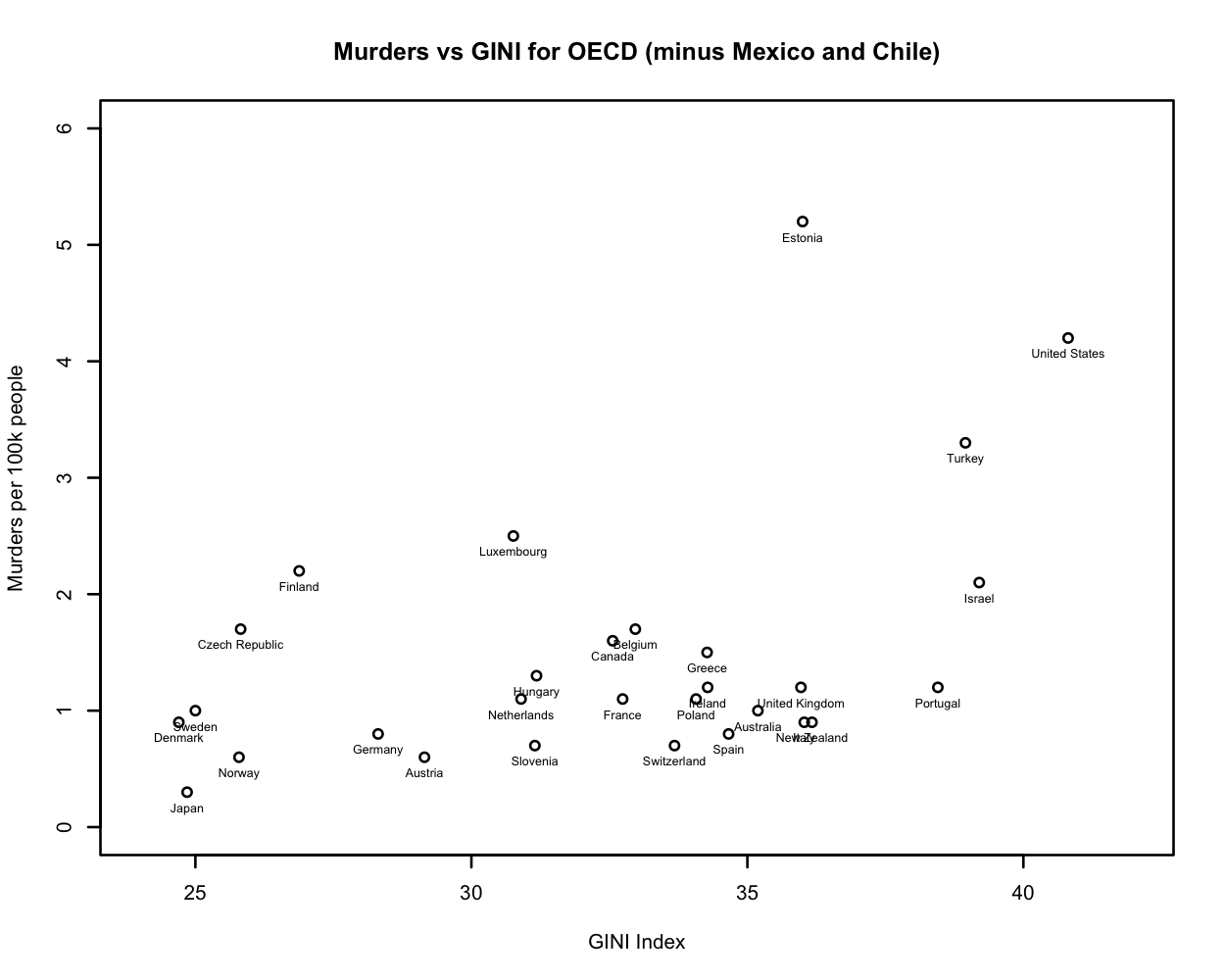I decided to plot country murder rates against gross domestic product per capita, and also against Gini coefficients. I scraped the data from these sources (.csv files at the end of the post if you’d like to use them).
This is what Murders vs GDP per capita look like. The Pearson correlation in the chart (r) is -0.32.
Murder rates vs. Gini indexes. r = 0.5
This the same chart as above, restricted to countries in the Organization for Economic Co-operation and Development (OECD):
And the same chart, zoomed in (Mexico and Chile are outside):
Finally, the data. One caveat: if you look at the World Bank spreadsheet, you will see that not all countries have current Gini statistics. I used the most recent one for each country. These charts might look different if all countries were current.
- murders.csv
- gini.csv
- gdp.csv
- oecd.csv (from Mark Reid).
Now, do I dare draw any conclusions from these charts? We see the correlations, but what do they mean? I see many poor countries with high murder rates and high inequality. We could speculate that the problem for those countries is the failure of rule of law. It’s even more tempting to guess what’s happening in the last chart. Developed countries like the US make it easier for individuals to become very wealthy, and don’t offer a comparatively good safety net for the relatively poor. This incentivizes people to work hard, start businesses, avoid poverty. Obviously not everyone will succeed. Perhaps the price to pay for this model is a higher murder rate.
Of course it would not be serious to arrive at that conclusion from these hasty charts, but I can pose the question. Feel free to play with the data, and to suggest other variables to analyze.




Since GDP is almost a function of IQ, you should do murders vs IQ next, if you could. Well done!
Kudos to you also for including the total homicide rate rather than the gun homicide rate alone, as the mendacious Guardian does. The way the Guardian makes it look, Sub-Saharan Africa is flowers and rainbows as far as the murder rate is concerned, when nothing could be further from the truth.
http://www.guardian.co.uk/news/datablog/2012/jul/22/gun-homicides-ownership-world-list
I also found some data on IQ vs homicide rate, with a moderate correlation coefficient of -0.46. However, not many countries are included.
http://inductivist.blogspot.com.au/2006/09/smart-countries-have-less-homicide.html
I suspect the IQ of the rest of the world vs homicide rate would be just as telling. Eyeballing it, the world homicide map is a color inverted image of the IQ map, with Russia and Greenland being the primary exceptions.
http://en.wikipedia.org/wiki/File:Map_of_world_by_intentional_homicide_rate.png
http://1.bp.blogspot.com/_4ify7vDXrDs/TBJxubU_IVI/AAAAAAAAF_k/kaI4PEQ2uzM/s1600/IQ_by_Country.png
It does make sense.
high IQ country:
-High GDP (from higher competence) -> Better funded, more competent police force.
-High IQ -> Most people reason that murder is a stupid decision, especially living in a country where you will get caught.
-High IQ -> High GDP -> Less desperate, more possible to get what you want via honest means.
low IQ country:
-Low GDP (from low competence) -> poorly funded police force, staffed by incompetent people.
-Low IQ -> If you kill someone, you probably won’t get caught because the police are useless. And lower IQ people tend not to look too far ahead, even if they do eventually get caught they think they won’t.
-Low IQ -> Low GDP -> More desperate, more competition over basics in life.
I also wonder if my earlier idea about the guns effecting an upper limit to homicides is really just a function of IQ or GDP. Consider that blacks murder at 7 times the rate that people of other races do, according to “The Color of Crime”. This means that the individual black murder rate in the USA is something like 14 per 100k. This means that if the guns are providing a disincentive to murder, the black murder rate is definitely not limited to the overall US average murder rate.
It looks like it’s true then the dominant factor in the homicide rate appears to be either ethnicity or IQ.
http://en.wikipedia.org/wiki/Gun_politics_in_Switzerland
The second amendment exists as a check and balance on government tyranny, not to secure hunting or private security against peers. Those arguments are secondary to the check and balance function. It’s crucial to understand this most, presently, un-pc fact.
Freedom of speech #1
Right to bear arms #2
You are on the right path evaluating correlations with financial means since money is the basic input for survival in the 1st world. However, you should continue down the rabbit hole into what drives income at the most basic level.
Where does money come from?
What drives the distribution of money across a population?
What happens when money is redistributed from producer to non-producer?
I’m sure you’ve met rags to riches people and known even more riches to rags people. What drives these outcomes from polar opposite beginnings?
Fewer than seven percent of all wars throughout history were of a religious genesis. Understanding the legal construct origin of money and the causality of war becomes very clear.
Individual with no money turns to legal deviance -crime and violence – to survive.
Government with no money turns to international diplomacy deviance – war.
http://en.wikipedia.org/wiki/Reification_(Marxism)
http://en.wikipedia.org/wiki/Religious_war
When the money runs out man tends to report the catalyst event(s), but those are accelerants/effects of an underlying breakdown of breakdown in the social contract(law).
http://legal-dictionary.thefreedictionary.com/Constitutor
http://en.wikipedia.org/wiki/Articles_of_Confederation
http://en.wikipedia.org/wiki/Shays'_Rebellion
http://en.wikipedia.org/wiki/Constitutional_Convention_(United_States)
http://en.wikipedia.org/wiki/Whiskey_Rebellion
My own (admittedly hasty) read of the data available from the OECD Better Life Index shows that the US has a higher than the OECD average homicide rate, but also a lower than average rate of violent assaults. Additionally, a higher proportion of the US (77% vs 67%) felt safe being out at night.
From these statistics I would hypothesize that the high rate of gun ownership in America makes the individuals safer from violent assault and increases their sense of safety while at the same time making those violent assaults that do happen more likely to be fatal.
I’ll have to look at the data further to see if my hypothesis works out.
Great posts on the subject, by the way.
Cheers.
I took the step of plotting homicide rate vs IQ of country. There is a very definite link between IQ and homicide rate, and it seems mainly to function as an upper bound. That is, the higher the IQ of the country, the lower the possible homicide rate. Higher IQ seems to be a civilizing factor. But within the greater homicide rates seemingly afforded by lower IQ, there is a great deal of variance. There are some relatively non-homicidal, low IQ populations. So there is more at work here than IQ.
As I was plotting the points, I noticed that there was another factor that appeared to be at work – race/ethnicity. The sub-regions in the wikipedia page were a very good guideline. Just looking at the vastly different sub-region averages should tell you that there is something at work here. Regions are a quite good approximation for race, and sub-regions are a pretty good approximation for sub-race/ethnicity. Could that be the causal factor?
http://en.wikipedia.org/wiki/List_of_countries_by_intentional_homicide_rate#By_subregion
Looking at the country table and clicking to sort by sub-region, the exceptions stuck out.
http://en.wikipedia.org/wiki/List_of_countries_by_intentional_homicide_rate#By_country
It seemed evident to me that the exceptions were probably of an racial/ethnic nature. Several things I knew made me draw that hypothesis.
1. The geographically logical groupings that wikipedia uses are roughly similar to racial groupings.
2. The genetic maps of the world made by Cavalli Sforza shows racial clines that more closely matches the variation seen in the homicide rates, and would explain the exceptions (note that this map does not include modern settlement).
http://en.wikipedia.org/wiki/File:The_history_and_geography_of_human_genes_Luigi_Luca_Cavalli-Sforza_map_genetic.png
The big sub-region exception in North Africa vs Sub-Saharan Africa is well explained genetically, being more Arab than African.
3. Colonies consisting primarily of founding country ethnic stock (e.g. Southern Europe -> Argentina, Chile, Uruguay, Western/Northern Europe -> USA, Australia, Canada) have homicide rates very similar to the founding countries.
So I separated homicide rate vs. country IQ by racial grouping, to make this relation clearer. (I cribbed this idea from La Griffe Du Lion: http://www.lagriffedulion.f2s.com/sft.htm) I used marker color to divide the broad racial categories – Europeans, Asians/North Africans, Amerinds, and Africans. Within those I selected regions, especially when I knew that there was relatedness, I grouped close ethnicities together as best I could.
Because of the topical nature of USA homicide rates, I also broke out the largest racial groupings within the USA – whites, blacks and Hispanics (mostly Amerind). Once broken out like that, it is evident that within that country, the homicide rates appear to be largely of a racial origin. The USA’s white homicide rate of around ~2/100k fits perfectly within the European range, including the areas from which most of its white people are drawn (Western, Northern-Germanic, Southern Europe). The USA’s black homicide rate is very similar to that of the West/Central African areas from which the slaves were taken (e.g. Benin, Ghana, Guinea, Nigeria, Senegal and Cote I’voire, Siera Leone, Angola etc.). The Hispanic homicide rate appears to be very similar to that of Mexico, where most of the Hispanic population comes from. I used the FBI stats to tease this information out.
http://i.imgur.com/dCa9U.jpg
Because the data suits a log scale better, I graphed it that way here:
http://i.imgur.com/J5Iuv.jpg
For some more information, it is worth reading the pdf at the following site:
http://www.colorofcrime.com/
In light of all of the above, it seems that race/ethnicity is a very good predictor of homicide rate. It is very hard to make an honest case that gun ownership is much of a factor at all in causing homicides. The evidence suggests that people(s) kill people, not guns. In heavily armed Switzerland, white USA, Serbia etc., the homicide rate is low. In mostly disarmed Netherlands, Poland and Italy, the homicide rate is also low. The common factor here is the European background.
In sub-Saharan African areas with more guns (Equatorial Guinea, Angola), homicide rates are high. In sub-Saharan African areas that have very few guns (Ghana, Ethiopia, Eritrea, in fact most of sub-Saharan Africa) homicide rates are also high. The common factor here is the sub-Saharan racial background.
The policy implications for countries wishing to minimize their homicide rates are obvious, but also sure to send the left into apoplexy.
@stats person
I came here via blog.jim.com and Steve Sailer.
Some non-PC comments.
1. Some of the raw data are not credible. The homicide rate in Somalia is supposed to be a mere 1.5 per 100k per year, despite a continuing low-level civil war. You have wisely excluded this point from your survey, but it raises questions about the rest of the dataset.
2. Countries with similar IQ have a factor of 10 range in homicide rate. Factors such as legislation, law enforcement, and culture can make a big difference.
3. Ignoring the Asian and African countries, the homicide rate seems to fall by a decade for every 10 points increase in IQ.
4. In Africa, the homicide rate is independent of IQ and does not exceed about 30 per 100k. Africans seem to be very restrained in not killing as many people as we would estimate from their IQ alone.
5. The homicide rate among US Blacks is the same as among Africans. However, two African countries have a homicide rate that is about a factor of 5 less than the African average. Can we learn anything from these countries (Djibouti, Niger), or is it a case of unreliable data?
I would suspect unreliable data for Niger, which is both a large country and very poor.
Djibouti is perhaps ethnically and culturally similar to the Arab world, and has a similarly low homicide rate.
Other outliers (scoring less than 8.0) in sub-Saharan Africa are the island states of Mauritius (2.5, but ethnically highly mixed) and São Tomé and Príncipe (1.9, two islands with very low population).
An outlier on the high side is Côte d’Ivoire (56.9) which has had violent political unrest.
The result is profoundly depressing. All the other countries of sub-Saharan Africa have a homicide rate between 8.0 and 38.0. The difference between the most and least murderous countries is a factor of 4.8, and it is well worth understanding the differences between different African countries.
However, this knowledge might not be so useful in the USA, where a homicide rate of 16 (guessed from your chart) for Black Americans is only a factor of two higher than for the least murderous African countries.
6. Perhaps the African comparison is irrelevant. Races in the USA all lie on the line described in (3) above. What factors correlate with IQ, not only among different races in the USA, but in the countries that fall on the same line?